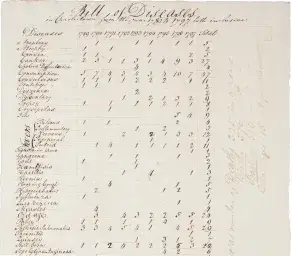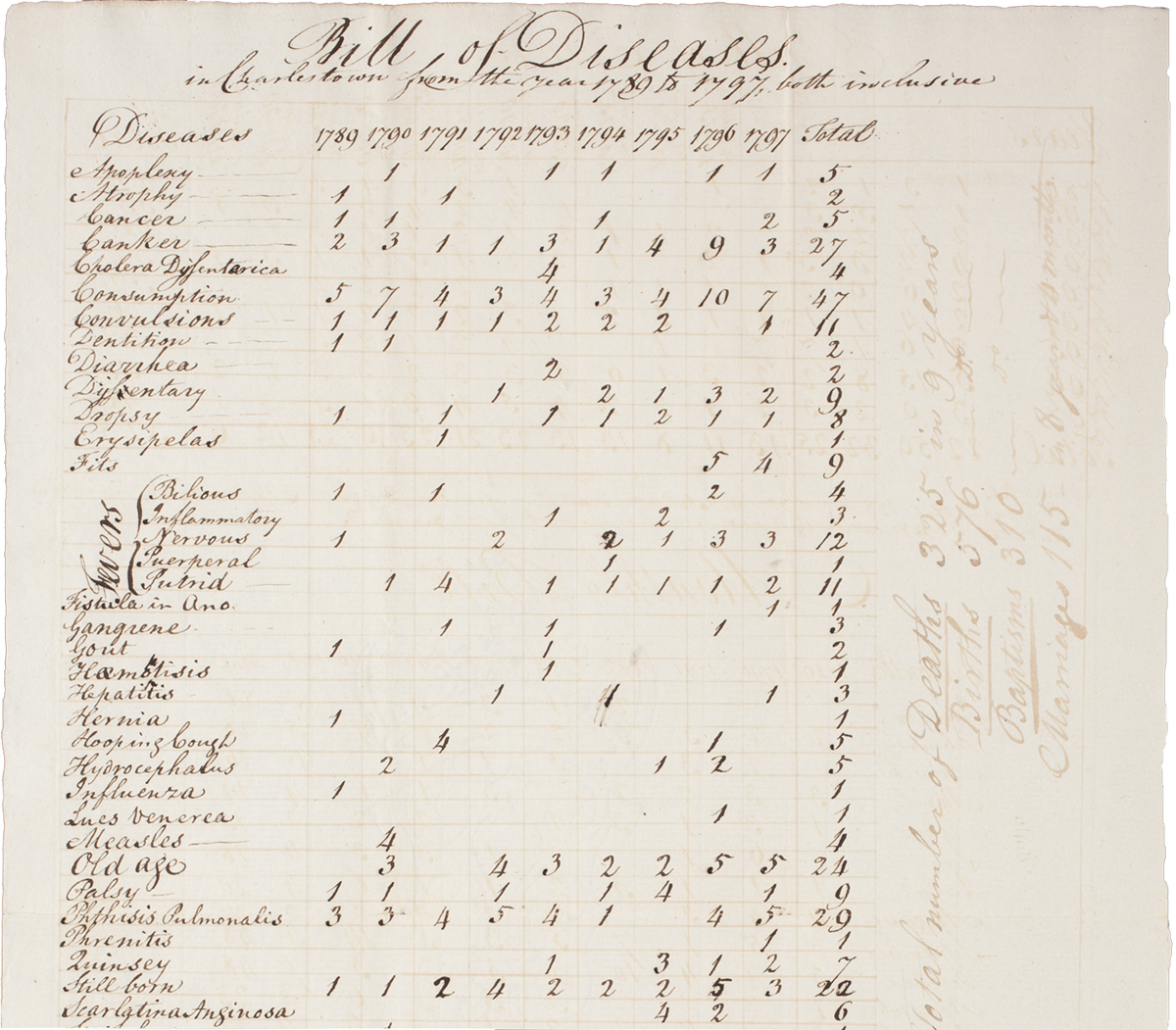Of “the several subjects which… should principally engage the attention of the Academy” from May 1781, the Members of the Academy voted:
“...That a fifth class examine the various diseases of the Country, what are most prevalent, the causes of disorders peculiar to the country, the longevity of the inhabitants, the ratio between births and deaths, the difference of this ratio in Sea-port towns and the country, in old and new settled parts of the country, the degrees of emigrations from different parts of the country to other parts : that Emigrants, however are not to be taken into the estimate for determining the ratio between the births and deaths in any particular district.”1
As part of these efforts, the Academy solicited and received vital statistics for communities throughout New England. These “Bills of Mortality” generally recorded the number of births and deaths for a year; cause of death was often enumerated as well. Occasionally there would be commentary about the particular situation of the town in relation to bodies of water, or meteorological observations such as average temperatures and precipitation. Some tables were concerned with the occupations of the citizenry, while others included interesting phenomena such as comets that may have passed, noted fires, etc.
In the transmittal letter for one of these statistical documents, Jedediah Morse (1761-1826; elected 1796) wrote:
“If similar communications were made from different parts of our country, a mass of materials would, in a course of years, be collected, from wh[ic]h a skillful person might compile tables, with accompanying remarks, which would shew the prevalent diseases in the United States―the probable causes of the prevalence of different diseases in different places, at in the several seasons of the year―the natural increase of inhabitants ―the comparative healthfulness of the several towns & larger districts of the United States &c. & in general the probability of the continuance of life in the several States.”2
A Bill of Mortality for the town of Salem in 1782 by Edward Augustus Holyoke (1728-1829; Charter member)appeared in the first volume of Memoirs, published in 17853. In the same volume, Edward Wigglesworth (1732-1794; Charter member) contributed “Observations on the Longevity of the Inhabitants of Ipswich and Hingham.”4 In the second volume of Memoirs that followed in 1793, Wigglesworth presented “A Table shewing the Probability of the Duration, the Decrement, and the Expectation of Life, in the States of Massachusetts and New-Hampshire, Formed from Sixty Two Bills of Mortality on the Files of the American Academy of Arts and Sciences, in the Year 1789.”5
Wigglesworth was particularly interested in the rate at which the New England population increased, and how long the population lived over several decades. Consequently the work of Wigglesworth, Holyoke, and others resulted in a significant achievement in data analysis: according to J. David Hacker, Wigglesworth constructed the first United States life table using Bills of Mortality for 35 New England towns in the late eighteenth century.”-6
In 1833, the Memoirs of the American Academy of Arts and Sciences, New Series, Vol. 1, featured four papers relating to life expectancy and quality of life, including “Tables of the Present Value of a Life-Annuity at Any Age, According to Dr. Wigglesworth’s Bill of Mortality” (pp. 73-78)7 by later Academy President J. Ingersoll Bowditch (1806-1889; elected 1934).
This early work in public health issues placed the institution in a position to advocate for larger policy changes. Wigglesworth’s life tables were used throughout Massachusetts, and were adopted by the state supreme court. Seeing the value to many disciplines of recording births, deaths, marriages, and other vital statistics, in 1841 the Academy joined with the Massachusetts Medical Society to bolster the efforts of individuals like Boston politician Lemuel Shattuck in petitioning the state to establish an official process for registering such information.8 As a result, portions of a Massachusetts bill introduced were passed in 1842, instructing town officials to record vital statistics.
In 1849, Shattuck secured enactment of authorization for the Governor to appoint the three Commissioners to prepare a sanitation Survey, relying in large part on the statistics gathered. The resulting “Shattuck Report”, the 1850 Report of the Sanitary Commission of the State of Massachusetts, was revolutionary in its scope and recommendations to create an organization of public health based on a state health department with local boards of health in each town.

